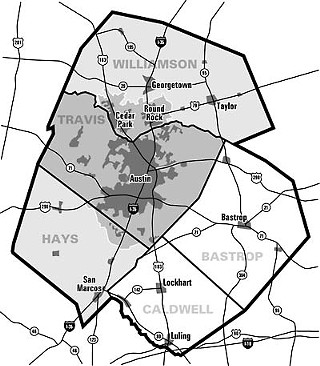Redrawing the Road Map
CAMPO expansion can change the rules of the transportation game
By Dave Mann, Fri., Jan. 31, 2003

Let's be honest; transportation planning can be rather dull. Most people tune out at the mere mention of a "transportation planning commission," knowing that if they don't, they risk exposure to detailed discussions of federal regulations that can take years off your life. But few issues are as critical to Austin's future, with expected population growth during the next 25 years further burdening already crowded roads. So it's a hot topic when the planners who determine the area's transportation future have to change their definition of what the "area" is and how its citizens can influence that future.
The Capital Area Metro Planning Organization -- CAMPO -- sounds like a sleeping bag manufacturer, but is one of Austin's most closely watched and criticized government bodies. Currently, CAMPO plans the transportation future for Travis Co. and adjoining slices of Hays and Williamson counties (including Round Rock, Cedar Park, and Leander). Nothing can get built -- at least not with the federal funds essential to any major transportation project -- unless CAMPO gives its approval. As the population of the Austin metro area -- which officially contains all of those three counties plus Bastrop and Caldwell -- has bulged and seeped farther into the surrounding Hill Country, many public officials have suggested CAMPO expand that planning area to match. By federal law, the CAMPO planning area must include the entire "urbanized area" -- a term of art of the Census Bureau -- around Austin, plus the fringe beyond that we can expect to become urbanized in the next 20 years. But nothing stops CAMPO from growing larger than that.
The CAMPO board, composed of 21 local and state officials and headed by state Sen. Gonzalo Barrientos, will almost certainly approve expansion when it next meets Feb. 10. But by how much, and with what consequences? Hays Co. officials have expressed concern that, if the whole county becomes part of CAMPO, a board dominated by Austin officials won't give their interests adequate consideration and might restrict funding for the county's many planned road projects. Meanwhile, some Austin leaders and activists fear that accepting more rural areas into CAMPO could make the organization -- which is already too highway-centric for Austin progressives' liking -- even more road-bound. If more rural counties have representation on the CAMPO board, they fear, money and support for alternative transportation modes such as rail, bike lanes, and HOV lanes will be sacrificed.
But as the board's vote on expansion -- already delayed once -- draws near, most fears have been allayed, said Mike Aulick, CAMPO's executive director. "It's been made pretty clear [that] you don't lose a whole lot coming in," he said, and CAMPO will almost assuredly vote to expand. The question now: Should CAMPO envelop just Williamson and Hays counties or include Bastrop and Caldwell as well? That's still up in the air, though several board members have openly endorsed the full five-county plan.
The vote has important consequences for the area's cooperative transportation planning -- or lack thereof. CAMPO, which has existed in some form since 1973, has two main functions. First, it mates travel patterns with population growth projections to compose a 25-year regional transportation plan. It then coordinates with the Texas Dept. of Transportation, city and county governments, and Capital Metro to put that plan into motion. CAMPO's second main function is approving use of federal transportation funds. This puts CAMPO in the middle of many divisive and incendiary issues -- I-35 and MoPac expansion, building SH 45 across the aquifer, building SH 130 to the east, light rail, commuter rail, inner-city road projects like Koenig Lane and South First, and on and on. (CAMPO also plays a lead role in local air-quality efforts.) It's basically the only regional government in Central Texas with any sharp teeth.
The "urbanized area" that CAMPO must include now stretches all the way to Hutto, and CAMPO is scheduled to update its long-range transportation plan for this expanded area by 2004. So, Aulick says, expanding CAMPO to include all of Williamson and Hays counties -- and adding appropriate representation from those areas to the CAMPO board -- would match CAMPO's structure up with its planning area. But with so many people moving to the Austin area and commuting into the city from surrounding counties, some board members began to wonder: If CAMPO will expand anyway, why not push the boundaries to include Bastrop and Caldwell counties, which are shouldering rising numbers of Austin commuters?
Tension over CAMPO expansion arose late last year. Williamson, Bastrop, and Caldwell counties enthusiastically endorsed joining CAMPO, but Hays Co. Commissioners were lukewarm on the idea. They voted in early December to join CAMPO only if all the county's already-planned road projects were included in CAMPO's 25-year plan. Hays officials wanted to ensure that joining CAMPO didn't mean surrendering too much control over road projects to Austinites, who currently hold a majority of CAMPO board seats. (Travis Co. has 15 of the 21 seats on the current board: all seven members, including Barrientos, of the Travis Co. legislative delegation; four Austin City Council members; three Travis Co. Commissioners; and one rep from the Capital Metro board.)

"They're afraid other jurisdictions will tell their jurisdiction what to do on transportation," Aulick said. "It's supposed to be a cooperative process. One county shouldn't tell another county what to do with its transportation."
Hays Co. Commissioner Bill Burnett, Hays' current lone representative on CAMPO's board, couldn't be reached for comment, but he told reporters after the December vote that he wouldn't include Hays in any arrangement that would harm the county's planned road projects. Aulick said the dispute was a misunderstanding over detailed federal regulations relating to transportation funding. The confusion postponed CAMPO's final decision on expansion, while CAMPO and TxDOT researched if Hays would jeopardize any road funding by joining CAMPO.
The answer, Aulick said, is no. "It's been made clear their eligibility for funds does not change by coming into CAMPO," he said. Aulick explained that CAMPO must construct a long-term financial projection to determine if it can pay for all its proposed projects. Essentially, CAMPO must show it can reasonably afford everything in its 25-year plan. Burnett was afraid Hays projects might get killed because they couldn't fit into CAMPO's 25-year outlook. The limits aren't hard and fast, though, Aulick said, since planning 25 years in advance is so imprecise. The regulations are in place to simply ensure CAMPO has to "have some dose of financial reality" and not stuff its plan with projects it could never pay for, he said, adding that everyone involved now understands that joining CAMPO and gaining a voice in addressing collective transportation problems shouldn't endanger any county's road funding.
The issue still lingering is three-county expansion versus the five-county plan. Several Austin board members, including Barrientos and Mayor Gus Garcia, have openly endorsed the five-county plan, saying it would give Bastrop and Caldwell greater say in regional transportation planning, and put CAMPO ahead of the game in planning for the expected rise in Austin commuters from those areas. In addition, a five-county CAMPO would match the Environmental Protection Agency's definition of the Austin metro area's air-quality non-attainment zone.
But several board members have said expanding to five counties will be "too much, too fast," Aulick said. They argue that expanding to three counties is the next logical step and that CAMPO should wait to see how much population growth actually occurs in Bastrop and Caldwell counties and how many people continue to commute from those areas. Some board members also worry that if the populations of Bastrop and Caldwell don't grow as expected, CAMPO will contain an awkward mix of urban and rural counties whose transportation needs are too different, or as Aulick put it, that "it will be like transportation apples and oranges. You're certainly going to have more growth in Travis County than in Bastrop, so most of the problems will be there. But you don't lose a lot by coming in, either."
Bill Garbade, TxDOT's Austin district chief, represents TxDOT on the CAMPO board and has openly favored limiting expansion to three counties instead of five. "He'd rather not see that happen in one fell swoop," said TxDOT spokesman John Hurt. "But we're going to work with [CAMPO] no matter what they decide." He said TxDOT had no read on how the vote would go, terming it a "pick it."
Rep. Mike Krusee, a Williamson Co. representative on the CAMPO board, believes most of the board will favor a "hybrid" approach, expanding first to three counties and then perhaps to five in the next year. He'd prefer CAMPO grow slowly, taking on Williamson and Hays, while granting Bastrop and Caldwell two ex officio board slots. "Going from one whole county to five whole counties seems like a lot," he said, adding that Caldwell Co. has only 30,000 people, which might make the CAMPO board disproportional if every member had a vote.
The potential makeup of an expanded CAMPO board has been another area of friction, with some rural areas fearing they would be underrepresented if a proposed "weighted" voting system were implemented. Aulick said he'd scrapped the "weighted" voting idea and that his latest board proposal seemed to mollify concerns. In a memo released earlier this month, Aulick suggested growing the CAMPO board from 21 to 22 members and promised every county at least one seat and every city with a population larger than 25,000 at least one seat. In all, Travis Co. would hold 14 seats under the plan, Williamson four, Hays two, and Bastrop and Caldwell one each.
No matter what the board decides on Feb. 10, most observers believe that CAMPO will inevitably expand to five counties, if not now then at least by 2007 when the next 25-year plan is due out.
Got something to say on the subject? Send a letter to the editor.








